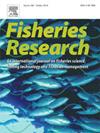Diet and trophic niches of sympatric Seriola species revealed by stomach content and multi-tissue stable isotope analyses
IF 2.2
2区 农林科学
Q2 FISHERIES
引用次数: 0
Abstract
Amberjacks in the family Carangidae are large, carnivorous pelagic fish that are highly targeted by fisheries globally. Seriola lalandi and Seriola quinqueradidata co-occur seasonally in the northern Yellow Sea and are caught by recreational fishers. This study used stomach content analysis (SCA) and stable isotope analysis (SIA) of δ13C and δ15N from liver and muscle tissues to investigate the dietary composition (including ontogenetic shifts), trophic niche breadth and overlap of these two species. This combination of techniques provides information on immediate diet (SCA), and short-term (∼3 months, liver SIA) and longer-term (∼5–6 months, muscle SIA) trophic assimilation. Both Seriola species were carnivorous, mainly feeding on fish, particularly the anchovy Engraulis japonicus, as well as crustaceans and cephalopods. Their diet shifts to larger-sized fish prey (e.g. mackerel Scomber japonicus) with ontogeny. Differences in δ13C values of liver and muscle were detected for both species, and for δ15N values for S. lalandi. Interspecific differences in δ15N and δ13C values for muscle and δ15N for liver were detected but no differences in δ13C values for liver tissue. δ15N values for liver and muscle were correlated with fork length in both species, suggesting a shift to higher-trophic level prey with ontogeny. Seriola lalandi had a broader trophic niche than S. quinqueradidata, indicating that the former species had a higher trophic diversity. Isotopic niche overlap between species were greater for the shorter-term liver (0.81) than longer-term muscle (0.39), which might reflect different overwintering habitats for the species or temporal-spatially partitioning in their pelagic habitat use during their reproductive migration. The study facilitated a better understanding of the trophic dynamics of sympatric Seriola species and provides information for implementing ecosystem-based fisheries management for these highly targeted species.
求助全文
约1分钟内获得全文
求助全文
来源期刊

Fisheries Research
农林科学-渔业
CiteScore
4.50
自引率
16.70%
发文量
294
审稿时长
15 weeks
期刊介绍:
This journal provides an international forum for the publication of papers in the areas of fisheries science, fishing technology, fisheries management and relevant socio-economics. The scope covers fisheries in salt, brackish and freshwater systems, and all aspects of associated ecology, environmental aspects of fisheries, and economics. Both theoretical and practical papers are acceptable, including laboratory and field experimental studies relevant to fisheries. Papers on the conservation of exploitable living resources are welcome. Review and Viewpoint articles are also published. As the specified areas inevitably impinge on and interrelate with each other, the approach of the journal is multidisciplinary, and authors are encouraged to emphasise the relevance of their own work to that of other disciplines. The journal is intended for fisheries scientists, biological oceanographers, gear technologists, economists, managers, administrators, policy makers and legislators.
 求助内容:
求助内容: 应助结果提醒方式:
应助结果提醒方式:


